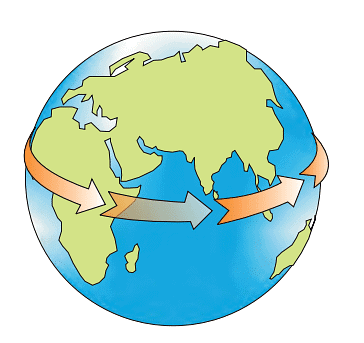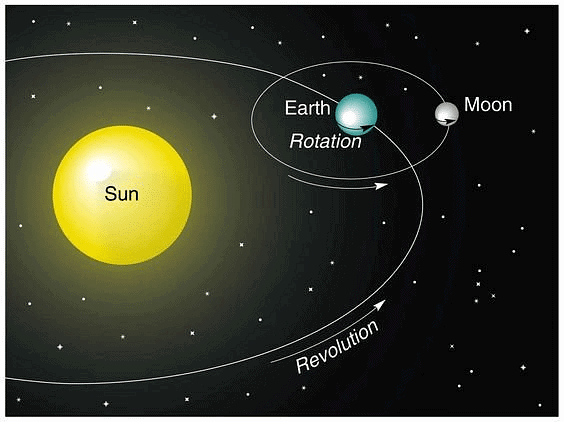Class 6 Geography Chapter 3 Notes - Motions of the Earth
Get ready to explore how Earth moves! This chapter is all about two important things it does: spinning around (rotation) and going in a big circle around the sun (revolution). These movements make day and night happen and bring us different seasons. Let's dive into the exciting world of the "Motions of the Earth" and discover how these dances in the sky shape our world!
 Motions of Earth
Motions of Earth
Earth's Rotation and Revolution:
Earth exhibits two primary motions: rotation and revolution.
 Earth's Rotation and Revolution
Earth's Rotation and Revolution
- Rotation: Rotation is the earth's movement on its axis, taking approximately 24 hours to complete one full rotation.
Revolution: Revolution is the earth's movement around the sun in a fixed orbit, taking approximately 365¼ days to complete one full revolution (a year).
Earth's Axis and Orbital Plane
- Angle 66½° : Earth's axis, an imaginary line, is tilted at an angle of 66½° to its orbital plane.
- Orbital Plane: The plane created by the earth's orbit is referred to as the orbital plane.
 Inclination of Earth's Axis and the Orbital Plane
Inclination of Earth's Axis and the Orbital Plane
Significance of Rotation: Day and Night on Earth
Earth's rotation on its axis creates the day-night cycle.
 Circle of Illumination
Circle of Illumination
- Due to the spherical shape of the earth, only half of the earth receives sunlight at any given time, causing day and night.
- As the Earth gets sunlight, only one-half of it is lit up at a time due to its spherical shape. The part facing the Sun has daylight, and the other half has night-time.
- The circle that divides day and night is called the circle of illumination.
- The Earth takes around 24 hours to complete one rotation, which is called Earth Day.
- What would happen if the earth did not rotate? If the Earth didn't rotate, one side would always have daylight and warmth, while the other side would be in darkness and freezing cold. Life would not be possible in these extreme conditions.
Significance of Revolution: Change of Seasons
Earth's revolution around the sun causes the change of seasons.
- Revolution is the movement of the Earth around the Sun in a fixed path or orbit. It takes 365¼ days (a year) to complete this journey.
- A year is divided into summer, winter, spring, and autumn based on the earth's position in its orbit.
- Leap Year Concept: We usually count a year as 365 days and overlook the extra six hours for convenience. Every four years, an extra day is added to February, making it 29 days instead of 28 days. This is because six hours are saved each year, which adds up to one day (24 hours) over four years. This year with 366 days, is known as a leap year.
Summer and Winter Solstice
Earth's orbit around the sun is elliptical. Throughout its orbit, the earth is inclined in the same direction. Seasons change due to the tilt of the earth's axis. A year is typically split into four seasons: summer, winter, spring, and autumn.
 Revolution of Earth and Change in Seasons
Revolution of Earth and Change in Seasons
Summer Solstice
On 21st June, the Northern Hemisphere experiences the Summer Solstice, with the North Pole tilted towards the sun.
- The sun's rays fall directly on the Tropic of Cancer, resulting in more heat.
- The North Pole and the places beyond the Arctic Circle experiences continuous daylight for about six months.
- The longest day and shortest night in the Northern Hemisphere occur on 21st June.
- It is the Winter season in the Southern Hemisphere, with longer nights and shorter days.
- This position of the earth is called the Summer Solstice.
Winter Solstice
On 22nd December, the Southern Hemisphere experiences the Winter Solstice, with the South Pole tilted towards the sun.
- The sun's rays fall vertically (23½° S) on the Tropic of Capricorn.
- The larger portion of the Southern Hemisphere gets light, resulting in summer.
- Therefore, it results in Longer days and shorter nights in the Southern Hemisphere.
- It is the Winter season in the Northern Hemisphere, with longer nights and shorter days.
- This position of the earth is called the Winter Solstice.
What is Equinox?
On 21st March and September 23rd, the entire earth experiences equal days and nights, known as equinoxes.
 Earth During Equinox
Earth During Equinox
- At this point, neither of the poles is tilted towards the sun, resulting in equal day and night durations across the globe.
- On 23rd September, the Northern Hemisphere experiences autumn, while the Southern Hemisphere has spring.
- Conversely, on the 21st March, the Northern Hemisphere enjoys spring, and the Southern Hemisphere has autumn.
Conclusion:
- Days, nights, and seasonal changes are a result of the earth's rotation and revolution.
- Understanding these motions is crucial for comprehending natural phenomena and the changing environment.
Important Questions
Q.1: Define rotation and revolution of the Earth.
Ans: Rotation: Movement of the Earth on its axis in nearly 24 hours is termed as rotation. It is also called the daily movement of the earth.
Revolution: Movement of the earth around the Sun on a fixed path or orbit is called revolution.
Q.2: What is the circle of illumination? Why does it not coincide with the axis of the Earth?
Ans: The circle which separates day from night is called the circle of illumination. The circle of illumination does not coincide with the axis of the Earth due to the planet's axial tilt. The Earth is tilted on its axis at an angle of approximately 23.5 degrees relative to its orbital plane around the Sun. This axial tilt is what causes the changing seasons on Earth.
Q.3: Distinguish between rotation and revolution.
Ans: The distinction between rotation and revolution is as under:
FAQs on Class 6 Geography Chapter 3 Notes - Motions of the Earth
| 1. What is the significance of Earth's rotation and revolution? |  |
| 2. How does Earth's axis and orbital plane affect its motions? |  |
| 3. What is the significance of the summer and winter solstice? |  |
| 4. What happens during an equinox? |  |
| 5. How do Earth's motions impact the length of day and night? |  |

















